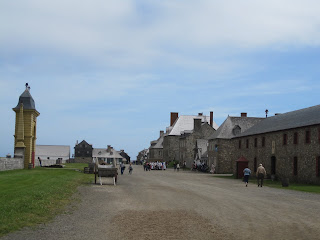céad mile fáilte ("kad meel-a fall-sha") translates as "a hundred thousand welcomes" and that's what we found when we headed on to Cape Breton Island. The people are tremendous and very quick to welcome you into their world. To maintain the Gaelic roots of the people, the Provincial Government supports Gaelic educational programs. Bilingual roadsigns are posted in English and Gaelic in those parts of the province originally settled by Gaelic speakers versus those in other provinces which are posted in English and French.
We stayed in a beautiful campground in Baddeck and had a chance to visit some of the highlights of the Island. After settling in on August 22, we headed out to explore the world famous Cabot Trail on the 23rd.
We stayed in a beautiful campground in Baddeck and had a chance to visit some of the highlights of the Island. After settling in on August 22, we headed out to explore the world famous Cabot Trail on the 23rd.
The Cabot Trail loops around the northern tip of Cape Breton, 185 miles or 298 km long. The Cape Breton Highlands National Park lies along the Cabot Trail, most known for providing world class hiking. The big commercial draw to the trail is whale watching, visiting the museums and galleries and sampling some of the finest sea food in the world.
We stopped at several shops along the Trail including a leather shop where we saw a lot of the usual leather goods but the artist, John C. Roberts told us about one of his greatest thrills, that being he was commissioned to produce all the leather buckets for the Russell Crowe's movie "Master and Commander" so if you ever watch the movie, remember all the leather buckets you see on the ship were made on Cape Breton. We also stopped at a very eclectic clothing store, a pewter jewellery store full of gaelic stuff, a Scottish/Irish heraldry/tartan shop, a great chowder house and a few others.
We stopped at several shops along the Trail including a leather shop where we saw a lot of the usual leather goods but the artist, John C. Roberts told us about one of his greatest thrills, that being he was commissioned to produce all the leather buckets for the Russell Crowe's movie "Master and Commander" so if you ever watch the movie, remember all the leather buckets you see on the ship were made on Cape Breton. We also stopped at a very eclectic clothing store, a pewter jewellery store full of gaelic stuff, a Scottish/Irish heraldry/tartan shop, a great chowder house and a few others.
The town's streets and actors,
That night on returning to Baddeck we attended the Baddeck Gathering Ceilidh. In modern usage a ceilidh (pronounced Kay Lee) is a traditional Gaelic social gathering and involves playing only Gaelic folk music and dancing. The evening was a huge success and we really enjoyed the music, the dancing and the atmosphere.
The next day we visited the summer home of Alexander Graham Bell (1845-1922) which is on Bras d'Or Lakes near Baddeck. There is a Parks Canada museum there which displays a lot of his artifacts, models, drawings, etc. Teaching deaf children to speak in order to talk to their parents was how he started out and then he expanded this to developing the telephone so we could all talk to each other. He then went on to research transmitting sound on sunlight, creating man-carrying kites, airplanes and a marine record-setting hydrofoil boat. It really was truly fascinating to read about his work, his ideas and then see how he developed them into real every day life.
Afterward we headed out to Mabou where we visited the Glenora Distillery. Their product, Glen Breton Rare Canadian Single Malt Whisky is the only single malt whisky produced in Canada. We had a great tour along with a few tastings and then off to lunch in the restaurant where a Ceilidh was happening. So, with a few Air do dheagh shlamtel! (To your excellent health) we enjoyed our visit. All the water used to make the whisky comes from one small creek on the property and is made entirely on site.
It's off to Halifax next where we will reach the eastern edge of our trip. Just a couple of scenic shots to finish off this entry.


















No comments:
Post a Comment